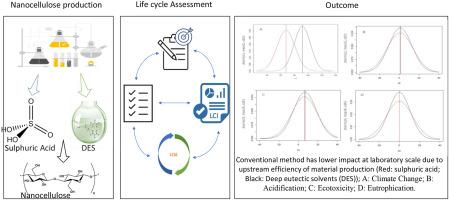在实验室规模上使用传统和新颖的方法评估纳米纤维素生产对环境的影响
IF 6.5
Q2 ENGINEERING, ENVIRONMENTAL
引用次数: 0
摘要
绿色化学促进化学产品和工艺的设计和应用,减少或最好消除有害物质的使用和产生。本研究的目的是评估在实验室规模上生产纳米纤维素的两种方法的环境性能:(i)传统的硫酸水解,已升级用于工业用途(TRL 8-9);(ii)新方法使用三元共晶混合物ChCl: pTSA: PA的摩尔比(1:1:1.35),目前为TRL 2。发展这种新方法的目的是从环境的角度寻找一种比传统方法更好的办法。为了验证这一点,使用生命周期评估来比较传统方法和新方法与生产的1克纳米纤维素的功能单位。系统边界从摇篮到实验室大门。结果被解释为选择实验室使用的最佳方法,并确定在新方法升级期间要解决的设计问题。对于传统方法和新方法,选择的影响类别是气候变化(kgCO2当量),酸化(kg SO2当量),生态空气(CTUe)和富营养化(kg N当量)。用硫酸生产1克纳米纤维素造成的气候影响在68千克二氧化碳当量(90%产量)到105千克二氧化碳当量(57%产量)之间。使用DES生产的气候影响范围从85公斤二氧化碳当量(90%产量)到132公斤二氧化碳当量(57%产量)。结果表明,新方法在全生命周期内产生了更大的影响。除非在升级过程中做出重大改变,否则这种新方法不会对可持续的循环生物经济做出积极贡献。该方法确实有改进的潜力,以减少影响,包括使用脱碳能源,一种可再生的生物基纤维素原料和氯化胆碱,以提高中试规模使用深度共晶溶剂(DES)的整体效率。如果只考虑分析的实验室阶段,低TRL生命周期评估提供的见解是不可能的。本文章由计算机程序翻译,如有差异,请以英文原文为准。

Evaluating the environmental impacts of nanocellulose production using conventional and novel approach at laboratory scale
Green chemistry promotes the design and application of chemical products and processes that reduce or preferably eliminate the use and generation of hazardous substances. The objective of this research was to evaluate the environmental performance of two methods of producing nanocellulose at the laboratory scale: (i) a conventional sulphuric acid hydrolysis that has been upscaled for industrial use (TRL 8–9); and (ii) the novel approach using the ternary eutectic mixture ChCl: pTSA: PA molar ratio (1:1:1.35) that is currently at TRL 2. The purpose of developing the new approach was to find a better alternative to the conventional process from an environmental perspective. To validate this, life cycle assessment was used to compare conventional vs novel methods with the functional unit of 1 g nanocellulose produced. The system boundary was from cradle to laboratory gate. The results were interpreted to select the best method for laboratory use and to identify design issues to address during upscaling of the novel method. For both methods, conventional and novel, the impact categories selected were climate change (kgCO2 eq), Acidification (kg SO2 eq), Ecotox Air (CTUe) and Eutrophication (kg N eq). To produce 1 g of nanocellulose with sulphuric acid caused a climate impact of between 68 kg CO2 eq (90 % yield) to 105 kg CO2 eq (57 % yield). Produced using DES the climate impact ranged from 85 kg CO2 eq.(90 % yield) to 132 kg CO2 (57 % yield). The results indicated that the novel method created greater impacts over the whole life cycle. Unless significant changes are made during upscaling, the novel method will not make a positive contribution to sustainable, circular bioeconomy. The method does have potential to be improved to reduce impact, including using decarbonised energy, a renewable, bio-based feedstock for the cellulose and choline chloride to improve the overall efficiency of using deep eutectic solvent (DES) at pilot scale. The low TRL life cycle assessment offered insights not possible if only the laboratory stage of the analysis had been considered.
求助全文
通过发布文献求助,成功后即可免费获取论文全文。
去求助
来源期刊

Cleaner Engineering and Technology
Engineering-Engineering (miscellaneous)
CiteScore
9.80
自引率
0.00%
发文量
218
审稿时长
21 weeks
 求助内容:
求助内容: 应助结果提醒方式:
应助结果提醒方式:


